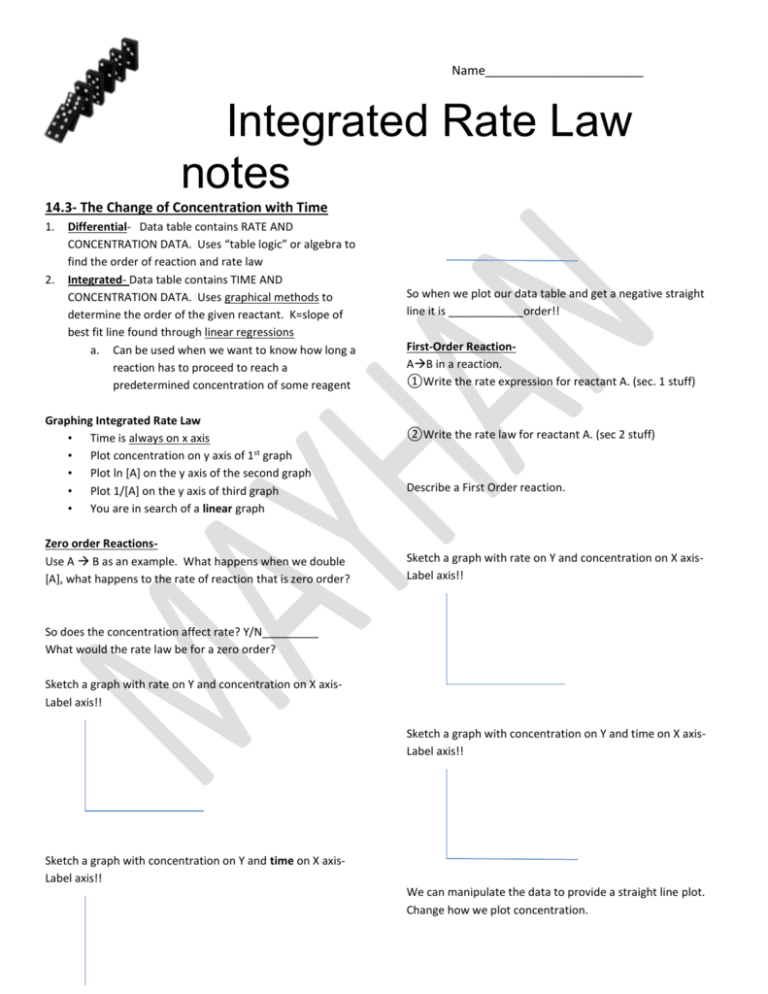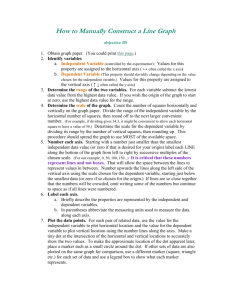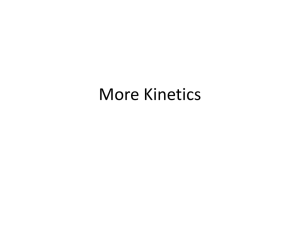MAYHAN Name_______________________ Integrated Rate Law
advertisement

Name_______________________ Integrated Rate Law notes 14.3- The Change of Concentration with Time 1. 2. Differential- Data table contains RATE AND CONCENTRATION DATA. Uses “table logic” or algebra to find the order of reaction and rate law Integrated- Data table contains TIME AND CONCENTRATION DATA. Uses graphical methods to determine the order of the given reactant. K=slope of best fit line found through linear regressions a. Can be used when we want to know how long a reaction has to proceed to reach a predetermined concentration of some reagent Graphing Integrated Rate Law • Time is always on x axis • Plot concentration on y axis of 1st graph • Plot ln [A] on the y axis of the second graph • Plot 1/[A] on the y axis of third graph • You are in search of a linear graph Zero order ReactionsUse A B as an example. What happens when we double [A], what happens to the rate of reaction that is zero order? So when we plot our data table and get a negative straight line it is ____________order!! First-Order ReactionAB in a reaction. ①Write the rate expression for reactant A. (sec. 1 stuff) ②Write the rate law for reactant A. (sec 2 stuff) Describe a First Order reaction. Sketch a graph with rate on Y and concentration on X axisLabel axis!! So does the concentration affect rate? Y/N_________ What would the rate law be for a zero order? Sketch a graph with rate on Y and concentration on X axisLabel axis!! Sketch a graph with concentration on Y and time on X axisLabel axis!! Sketch a graph with concentration on Y and time on X axisLabel axis!! We can manipulate the data to provide a straight line plot. Change how we plot concentration. Take equations ① and ② and smash them together. How do you use this equation to solve for concentration? Using calculus to integrate the rate law for a first-order process gives us. Practice Exercise The decomposition of dimethyl ether, (CH3)2O, at 510 ºC is a first-order process with a rate constant of 6.8 10–4 s–1: (CH3)2O(g) CH4(g) + H2(g) + CO(g) If the initial pressure of (CH3)2O is 135 torr, what is its pressure after 1420 s? Using calculus to integrate the rate law for a first-order process gives us. Second-Order ReactionDescribe a second-order reaction. Where, [A]0 is the initial concentration of A. [A]t is the concentration of A at some time, t, during the course of the reaction. Sketch a graph with rate on Y and concentration on X axisLabel axis!! Integrated Law for 1st order is Relate this equation to the slope. Therefore, if a reaction is first-order, a plot of ln [A] vs. time will yield a straight line, and the slope of the line will be -k. Let’s look at the integrated 1st order equation. Sample problem 14.5 The decomposition of a certain insecticide in water at 12 C follows first-order kinetics with a rate constant of 1.45 yr1. A quantity of this insecticide is washed into a lake on June 1, leading to a concentration of 5.0 107 g/cm3. Assume that the average temperature of the lake is 12 ºC. (a) What is the concentration of the insecticide on June 1 of the following year? Sketch a graph with concentration on Y and time on X axisLabel axis!! We can manipulate the data to provide a straight line plot. Change how we plot concentration. How do you use this equation to solve for concentration? Using calculus to integrate the rate law for a first-order process gives us. (b) How long will it take for the insecticide concentration to decrease to 3.0 10–7 g/cm3? What does second order reactions depend on? Sample Exercise 14.7 The following data were obtained for the gas-phase decomposition of nitrogen dioxide at 300 ºC, Time (s) [NO2], M 0.0 0.01000 50.0 0.00787 100.0 0.00649 200.0 0.00481 300.0 0.00380 ln [NO2] 1/ [NO2] Is the reaction first or second order in NO2? Fill in Blanks! Let’s graph the ln[NO2] to see if its 1st order Practice with graphs- After creating regression graphs of various reactions; provide the rate order for each graph. Is your graph linear?______ then it is/isn’t ________ order. What order is this reaction and what formula would I use to calculate various times/concentrations? Let’s graph the 1/[NO2] to see if its 2nd order What order is this reaction and what formula would I use to calculate various times/concentrations? Is your graph linear?______ then it is/isn’t ________ order. Summary on Integrated Rate Laws What order is this reaction and what formula would I use to calculate various times/concentrations?







